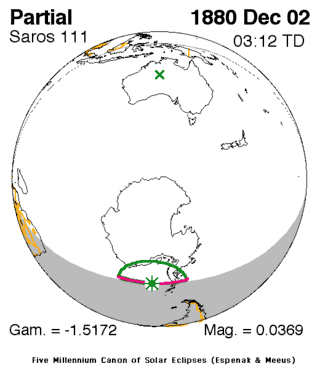Solar eclipse of December 2, 1880
| Solar eclipse of December 31, 1880 | |
|---|---|
 Map | |
| Type of eclipse | |
| Nature | Partial |
| Gamma | -1.5172 |
| Magnitude | 0.0369 |
| Maximum eclipse | |
| Coordinates | 67°48′S 42°54′W / 67.8°S 42.9°W |
| Times (UTC) | |
| Greatest eclipse | 3:11:33 |
| References | |
| Saros | 111 (76 of 79) |
| Catalog # (SE5000) | 9236 |
A partial solar eclipse occurred on December 2, 1880 during spring. A solar eclipse occurs when the Moon passes between Earth and the Sun, thereby totally or partly obscuring the image of the Sun for a viewer on Earth. A partial solar eclipse occurs in the polar regions of the Earth when the center of the Moon's shadow misses the Earth.
It was the last of four eclipses that took place that year, the last two that were partial.[1] It was the last four of solar saros 111, the next eclipses of the cycle were on December 13, 1898, December 24, 1916 and January 5, 1935.[2]
Description
The eclipse took place in the northernmost areas in Antarctica west of the Prime Meridian and includes the northcentral peninsular portion with much of its ice shelf, all of it occurred only in the Western Hemisphere. The eclipse started at sunrise and ended at sunset. At the peninsular portion, it occurred in the late evening hours of December 1. The greatest eclipse was in the Atlantic off the shore of Antarctica just over 75 miles (125 km) south of the Antarctic Circle at 67.8 S & 49.2 W at 3:11 UTC (12:11 AM local time.[1] As the moon moved towards the right on the Moon, in that part of Antarctica north of the South Pole at the 40th meridian west, it was seen as it was moved towards the right as the axis spinned at around the 68th parallel south.
The eclipse went as far as hundreds of miles (or kilometers) south of East London, South Africa and around the same parallel with Cape Town. The eclipse started at sunrise in the Indian Ocean and ended at sunset in Antarctica. A very small part occurred on the location of the previous eclipse, many areas occurred on the opposite side.
At one part of the peninsula, it showed at 1% obscuration, the remainder showed up to over 3.5% obscuration of the sun. The center of the Moon's shadow was missed by about 2,600 km above the area south of the Antarctic Circle.
See also
- List of solar eclipses in the 19th century
- List of solar eclipses visible from Antarctica
References
- 1 2 "Solar eclipse of December 2, 1880". NASA. Retrieved March 22, 2017.
- ↑ "Solar Saros 111". NASA. Retrieved March 22, 2017.
